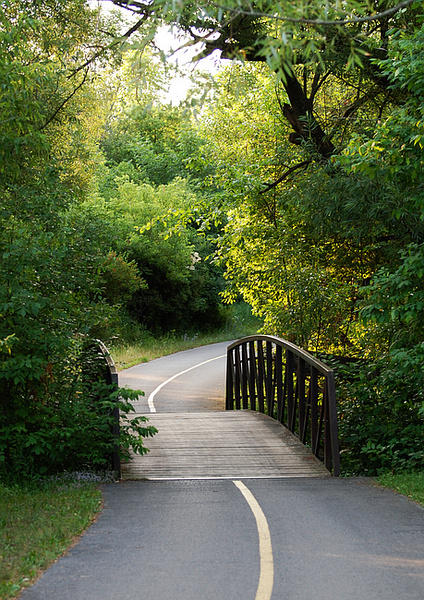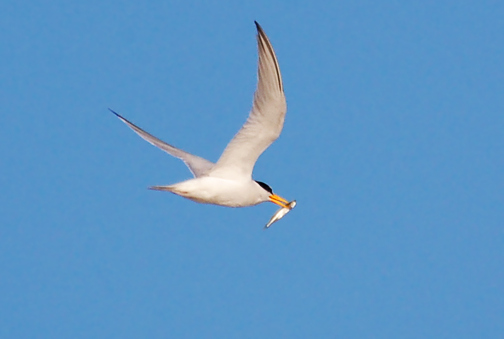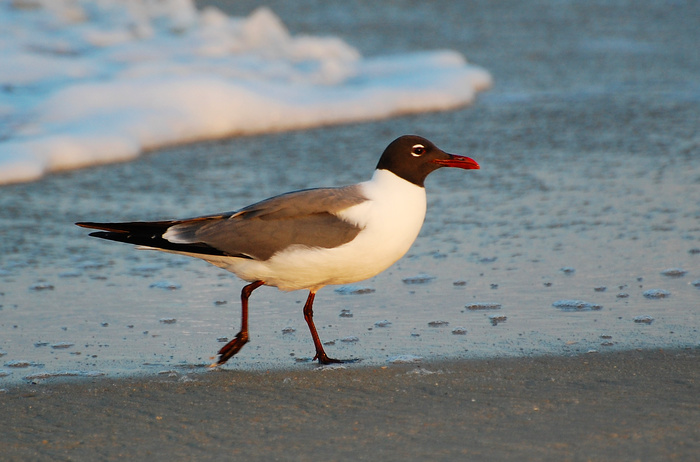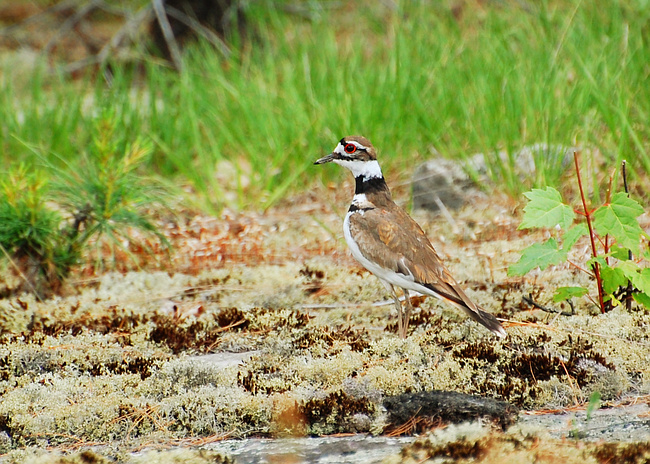
Amber on violet
July 16th, 2012
European Skippers, an introduced species. These pretty skippers can be very abundant during their flight time. The flowers they're nectaring on, cow vetch, are also a European import.

A youngster in the meadow
July 14th, 2012
Found this darling off Watts Creek Trail last week.

1680x1050 wallpaper

A shot with mom:

Watts Creek Trail
July 11th, 2012


Summer 2012 Hatteras Triplist
July 9th, 2012
( Herein )
One good tern deserves another
July 7th, 2012
(Yeah I know, I've used the joke before.)
I always enjoy tern-watching on the coast. More to the point tern-photographing, as I find it almost impossible to identify tern species in flight unless I can "freeze frame" them with a photograph, and study fine details at leisure. This is a Royal Tern, the common large tern of the Outer Banks:

And here is something a little more interesting--though I didn't realize it until I looked at the photo back home.

A Caspian Tern. Note the subtle yellow and black tip to its coral-red beak, and the heavy black patches under the wingtips. The black forehead is also a giveaway. Royal Terns have black foreheads too in breeding plumage, but they start molting in late May, so by mid-June they all have, as it were, receding hairlines.
Of course, here in Ottawa, Royal Tern would be the exciting one! It's an exclusively coastal bird, whereas Caspian Terns are occasionally seen along the Ottawa River in migration.

A Least Tern carries a fish back to its young. These terns are as small as songbirds, delicate and swallowlike as they flit over the ocean surf. While most of their relatives prefer the safety of salt marshes or deserted islands for raising young, Least Terns nest right on the beaches of Cape Hatteras. Like other beach-nesters, they are very vulnerable to human disturbance, so at Outer Banks their preferred (pristine, undeveloped) beaches are cordoned off during the breeding season.
This is a Good Thing. But I still envy the person who got close enough to a colony to take this, perhaps the most adorable nature photo I've ever seen.
More Hatteras highlights
July 2nd, 2012
White Ibises are "gimmes" for a birder at Pea Island Wildlife Refuge--you're just about guaranteed to see them. I have yet to find their gorgeous iridescent relative the Glossy Ibis, though it occurs in the Outer Banks also. Maybe someday!

1680x1050 wallpaper

I've seen these pretty red and yellow flowers at Outer Banks since I was a little girl. Until recently, I just assumed they were native. They're called "Indian blankets" or "firewheels", formally "gaillardia aristata", and actually they're only native in western North America. (I photographed some in the Okanagan, different color scheme but same species, I think.) They were introduced by Joseph Nash Bell, as recounted here, in the early 1900's. They thrive in sandy soil and are even salt-tolerant, so they've taken to their new home as if they'd been there all along! The locals call them "joe bell flowers."
( Click for more (Marbled Godwits, Sanderlings, Fish Crow and others) )
Surf birds at Cape Hatteras
June 28th, 2012

Laughing Gull, wallpaper available

1680x1050 wallpaper
Boat-Tailed Grackles are crow-sized blackbirds adapted to a coastal lifestyle. Of the various songbirds on Hatteras, few of them show up on the outer beaches. Boat-Tailed Grackles are a notable exception. They forage at the edge of the surf, digging for small invertebrates. This week they were fattening themselves on mole crabs (a.k.a. sand bugs), little beetle-shaped crabs that burrow in wet sand. When coquina clams (another burrower at surf edges) are abundant, they'll eat those, using their beaks like nutcrackers.
When a wave washes in, they leap and flutter to keep their balance.

1680x1050 wallpaper
( More (Black-Bellied Plover) )
If nothing else, it makes for good stories!
June 27th, 2012
We're back from vacation. It was a vacation of extremes, high and low--sometimes overlapping.
On the second day after our arrival at Hatteras, Mike and I made an hour-and-a-half trip to the mainland to Palmetto-Peartree Reserve in search of Red-Cockaded Woodpeckers, a rare and endangered species linked to old-growth pine savannahs. They are unusual in a number of ways, one being that they are the only North American woodpecker to dig their nest holes out of living wood, using the resulting flow of sticky sap as a deterrent against tree-climbing predators such as rat snakes.
I had no idea how off the grid PPR is. There were no outhouses, no rangers, no cars going by, not a soul in sight other than us. We drove down a muddy, slippery road with insufficient gravel, and ended up sliding into the ditch. We had to walk back to the main road before we could even get a signal on the cell phone to call a tow truck to pull us out, to the tune of $150 because he knew he had us over a barrel. We forgot to bring any sort of food (despite having eaten a very small breakfast), and left the sunblock in the car and forgot about it until we'd hiked a half hour and were now under the blazing midday sun in an unshaded wetland. Deer flies were abundant, and while the Off more or less kept them at bay, it didn't prevent me from waking up a few hours after our return with a tick embedded in my belly.
Lesson learned: do not trifle with mother nature. At least not in North Carolina.
For our trouble, I did not see any Red-Cockaded Woodpeckers. (Well, I may have. But far from satisfying and not enough to lifelist it.) But there were payoffs. It was one of the wildest places I've ever encountered, with tall, spindly, ancient-looking Loblolly pines, rich wetlands with reed beds towering over us, and pristine vistas over the Albemarle Sound. Green Herons, whom I have always thought of as shy and solitary birds that skulk around pond edges, were abundantly visible. They constantly flew back and forth across the road perching in those ancient pine trees. I'm sure they had a rookery up there.
For me, the greatest pleasure in encountering a bird is when it is utterly wild. I've seen many Osprey at Outer Banks, nesting on man-made platforms on top of man-made pylons, and paying humans little mind because they're long used to the sight of us. The pair of Osprey we met at PPR were nesting in a treetop, and they acted like they'd never seen a human being before in their lives. Though we were hundreds of feet away from their nest and could not have gotten closer without wading through knee-deep water, our presence incensed them. They circled over us calling franticly.
The Virginia part of my vacation was extremely buggy. Not mosquitos--mosquitos are trivial. Ticks and chiggers. The woods around and near my parents' neighborhood are excellent for birding, but they are also heavily infested. Over the course of the week I picked on the order of twenty ticks off my body, ranging from tiny pinpoint-sized ones (Lyme Disease!) to big ones with spots on them (Rocky Mountain Spotted Fever!) I also got a rather nasty case of chiggers that left oozing, furiously itching sores all over my legs and middle, one of which is still scabbed over. However, in the very place that I probably picked up those chiggers (Swift Creek Trail), I got a thrilling life bird, Hooded Warbler, a gorgeous southeastern warbler with a black cowl encircling a vivid yellow cheek. (I didn't get any photos, so click on the link if you want to see a picture.) Was it worth it? Yes, ten times over.
In the coming days I'll share some of my Cape Hatteras photos.
King of butterflies
June 7th, 2012

1680x1050 wallpaper
Nesting Killdeer at South March
June 4th, 2012
In the east part of South March Conservation Forest is a large beaver pond called Heron Pond. At its north shore is some of the most unique geology I've seen in Ottawa: a vast sandstone barren, dotted with short pine trees, and encrusted with a rich variety of mosses, lichens, grasses and wildflowers. It's been said that the plain dates back to the Paleozoic era. I've seen a pair of nighthawks courting above it: the male flying close to the female, then diving straight down and veering up suddenly with a *whoosh* of his wings (you can hear it from a distance.) Nighthawks are a species in decline and considered At Risk in Canada, and I find this rather significant as that part of the forest is not conservation area: it's owned by a developer and could be lost in the future.
Another species I've found breeding on the sandstone plain--though I doubt any conservationists will take interest is this one--is Killdeer! Killdeer are the most successful plovers in North America, and that's because they're so at ease with the changes humans make to the environment. I've seen them in farmland, equestrian parks, on manicured lawns and in parking lots, but this was the first time I'd seen breeding killdeer in an utterly wild, natural environment...and there was something enchanting about that.


Because killdeer nest on open ground, their eggs and young are vulnerable. So they've evolved means to distract predators away from the nest, generally by acting helpless. If the predator thinks it can easily catch the adult, why bother with the young? It's easy to feel like a louse while pursuing a killdeer for a photo: they cry so pitiably. They sound like they're in such deep distress. One tries to remember that the deep distress is an act. Real distress would be if you got close to their nest--and as long as you follow where they lead, that's sure not to happen.
The crown jewel of the repertoire is the famous broken wing display. The parent killdeer sits down, fans its eye-catching orange tail, sticks its wings out at odd angles, and flops around like a poor, pathetic fish out of water.

|
